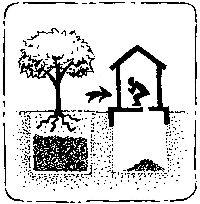
When a pit is full, it can simply be filled with soil and covered. Although there is no benefit recovered, the full pit poses no immediate health risk, and with time, the contents will degrade naturally. Alternatively, the 'Arborloo' is a shallow pit that is filled with excreta and soil/ash and then covered with soil; a tree planted on top will grow vigorously in the nutrient-rich pit.
When a single pit or a single VIP is full, and can not be emptied, Fill and Cover, i.e. filling the remainder of the pit and covering it is an option, albeit one with limited benefits to the environment or the user.
In the Arborloo, a tree is planted on top of the full pit while the superstructure, ring beam and slab are continuously moved from pit to pit in an endless cycle (usually moved once every 6 to12 months). A shallow pit is needed, about 1m deep. The pit should not be lined as the lining would prevent the tree or plant from growing properly. Before the pit is used, a layer of leaves is put into the bottom. After each defecation, a cup of soil, ash or a mixture should be dumped into the pit to cover the excreta. If they are available, leaves can also be added occasionally to improve the porosity and air content of the pile. When the pit is full, the top 15cm of the pit is filled with soil and a tree is planted in the soil. Banana, papaya and guava trees (among many) have all proven to be successful. A tree should not be planted directly in the raw excreta. The tree starts to grow in the soil and its roots penetrate the composting pits as it grows. It may be best to wait for the rainy season before planting if water is scarce. Other plants such as tomatoes and pumpkins can also be planted on top of the pit if trees are not available.
| Advantages | Disadvantages |
|---|---|
|
|
Adequacy[edit | edit source]
Filling and covering pits is an adequate solution when emptying is not possible and when there is space to continuously re-dig and fill pits. The Arborloo can be applied in rural, peri-urban, and denser areas if space is available. Planting a tree in the abandoned pit is a good way to reforest an area, provide a sustainable source of fresh fruit and prevent people from falling into old pit sites.
Health Aspects/Acceptance[edit | edit source]
There is a minimal risk of infection if the pit is properly covered and clearly marked. It may be preferable to cover the pit and plant a tree rather than have the pit emptied, especially if there is no appropriate technology available for treating the faecal sludge. Users do not come in contact with the faecal material and thus there is a very low risk of pathogen transmission. Demonstration projects that allow community members to participate are useful ways of showing both the ease of the system, it's inoffensive nature, and the nutrient value of composted excreta.
Maintenance[edit | edit source]
A cup of soil and/or ash should be added to the pit after each defecation and leaves should be added periodically. Also, the contents of the pit should be periodically levelled to prevent a coneshape from forming in the middle of the pit. There is little maintenance associated with a closed pit other than taking care of the tree or plant. If a tree is planted in the abandoned pit, it should be watered regularly. A small-fence should be constructed with sticks and sacks around the sapling to protect it from animals.
References[edit | edit source]
- Morgan, P. (2007). Toilets that make compost. Stockholm Environment Institute, Stockholm, Sweden. pp 81–90.
- Morgan, P. (2004). An Ecological Approach to Sanitation in Africa: A Compilation of Experiences. Aquamor, Harare, Zimbabwe. Chapter 10 – The usefulness of urine.
- NWP (2006). Smart Sanitation Solutions. Examples of innovative, low-cost technologies for toilets, collection, transportation, treatment and use of sanitation products. Netherlands Water Partnership, The Netherlands. pp 51.
Acknowledgements[edit | edit source]
The material on this page was adapted from:
Tilley, E. et al. (2008). Compendium of Sanitation Systems and Technologies, published by Sandec, the Department of Water and Sanitation in Developing Countries of Eawag, the Swiss Federal Institute of Aquatic Science and Technology, Dübendorf, Switzerland.
The publication is available in English, French, and will be made available in Spanish. Available in the IRC Digital Library
Safety and risk[edit | edit source]
Stenström[1] et al conducted a risk assessment of many common components used in WASH systems. They concluded arborloo systems were low frequency, low risk for user users and medium risk for planters.
For more discussion on these issues, see Infection risk from Ecosan